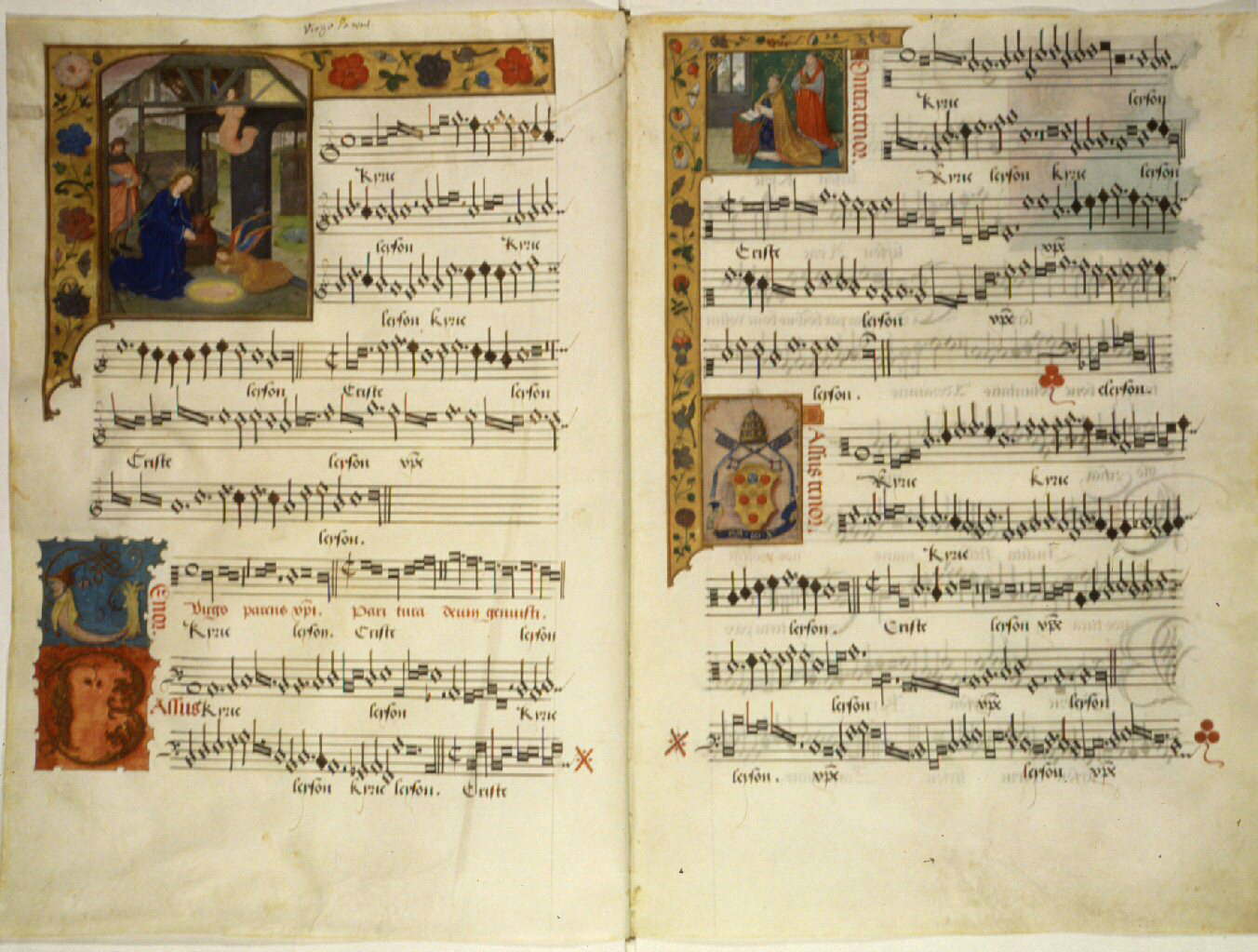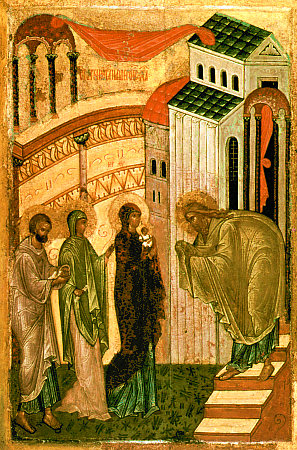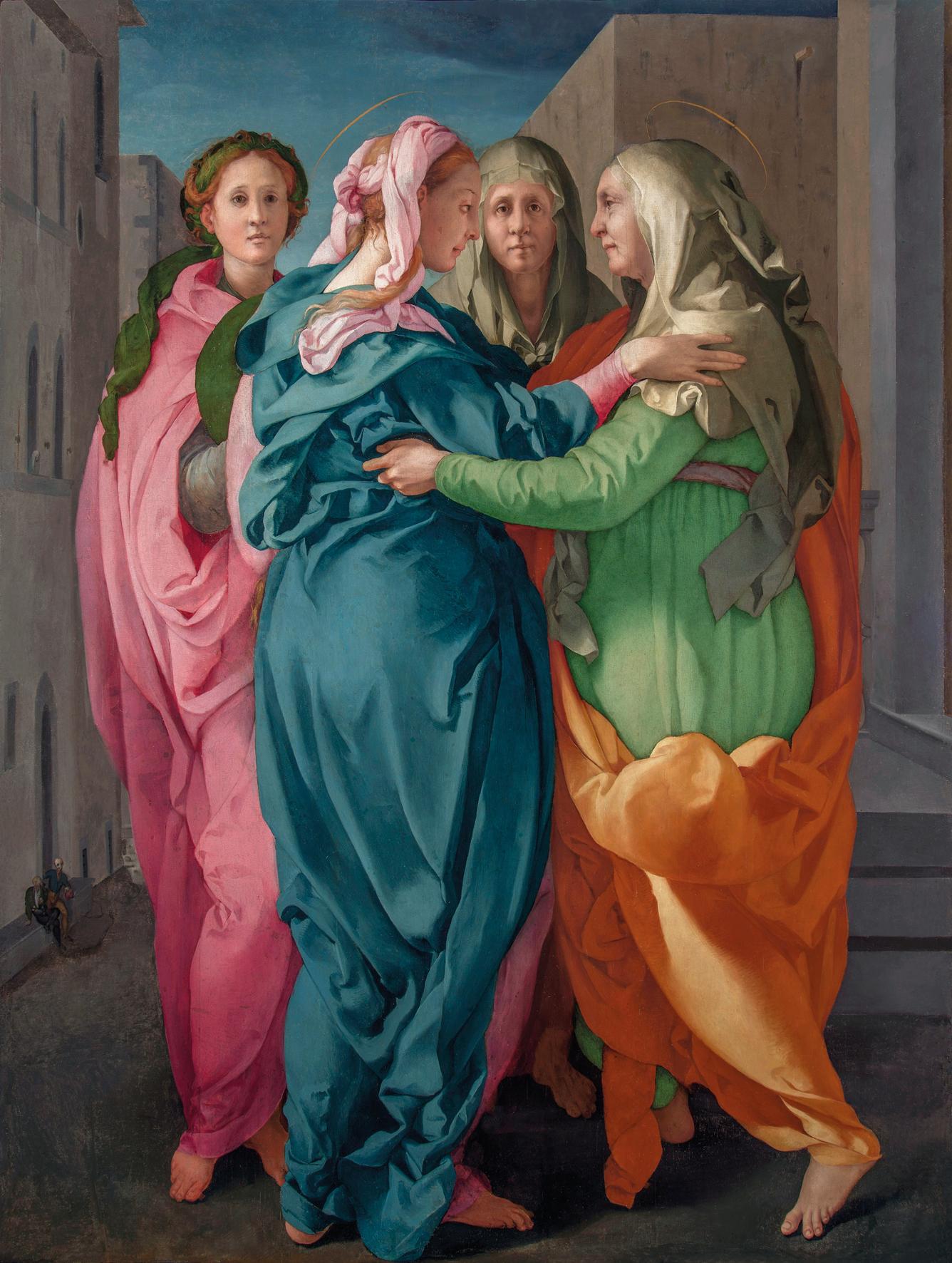|
Collegium Regale (Howells)
is a collection of choral settings by the English composer Herbert Howells of the canticles for the Anglican services of Mattins, Holy Communion and Evening Prayer. Scored for four-part choir, solo tenor and organ, the pieces were written between 1944 and 1956 "for the King's College, Cambridge" ( in Latin). The first of the pieces were first published by Novello in 1947, and they have become a popular piece of music in the Anglican church music repertoire. Text The text of the first service setting for the daily service of Mattins in the Anglican church consists of two pieces: the , an ancient Latin Christian hymn; and the a setting of Psalm 100. The setting of the evening canticles, part of the Anglican daily service of Evening Prayer, consists of the (''Song of Mary'') and (''Song of Simeon''). Mary sings the Magnificat ("My soul doth magnify the Lord") on the occasion of her visit to Elizabeth, as narrated in the Gospel of Luke (). Simeon sings the Nunc di ... [...More Info...] [...Related Items...] OR: [Wikipedia] [Google] [Baidu] |
King's College, Cambridge
King's College, formally The King's College of Our Lady and Saint Nicholas in Cambridge, is a List of colleges of the University of Cambridge, constituent college of the University of Cambridge. The college lies beside the River Cam and faces out onto King's Parade in the centre of the city. King's was founded in 1441 by King Henry VI of England, Henry VI soon after founding its sister institution, Eton College. Initially, King's accepted only students from Eton College. However, the king's plans for King's College were disrupted by the Wars of the Roses and the resultant scarcity of funds, and then his eventual deposition. Little progress was made on the project until 1508, when King Henry VII of England, Henry VII began to take an interest in the college, probably as a political move to legitimise his new position. The building of the college's chapel began in 1446, and was finished in 1544 during the reign of Henry VIII. King's College Chapel, Cambridge, King's College Chap ... [...More Info...] [...Related Items...] OR: [Wikipedia] [Google] [Baidu] |
Novello & Co
Wise Music Group is a global music publisher, with headquarters in Berners Street, London. In February 2020, Wise Music Group changed its name from The Music Sales Group. In 2014 Wise Music Group (as The Music Sales Group) acquired French classical music publisher Éditions Alphonse Leduc. Éditions Alphonse Leduc publishes classical music by French composers including Jacques Ibert, Henri Dutilleux, Olivier Messiaen, Francis Poulenc, and Joseph Canteloube. It also publishes operatic works by Italian composers Gioachino Rossini and Vincenzo Bellini, and works by Muzio Clementi, Muzio Clémenti, Johannes Brahms, and Pyotr Ilyich Tchaikovsky, Pyotr Tchaikovsky. In March 2017, The Music Sales Group acquired disco publisher Bleu Blanc Rouge from Belgian record producer and songwriter Jean Kluger. In April 2018, Music Sales sold its physical and online print divisions, including Musicroom, to Milwaukee-based publisher Hal Leonard for $50 million. Hal Leonard will continue to distri ... [...More Info...] [...Related Items...] OR: [Wikipedia] [Google] [Baidu] |
Credo
In Christian liturgy, the credo (; Latin for "I believe") is the portion of the Mass where a creed is recited or sung. The Nicene-Constantinopolitan Creed or the Apostles' Creed are the primary creeds used for this purpose. History After the formulation of the Nicene Creed, its initial liturgical use was in baptism, which explains why the text uses the singular "I ..." instead of "we ...". The text was gradually incorporated into the liturgies, first in the east and in Spain, and gradually into the north, from the sixth to the ninth centuries. In 1014 it was accepted by the Church of Rome as a legitimate part of the Mass. It is recited in the Western Mass directly after the homily on all Sundays and solemnities; in modern celebrations of the Tridentine Mass as an extraordinary form of the Roman Rite, the Credo is recited on all Sundays, feasts of the I class, II class feasts of the Lord and of the Blessed Virgin, on the days within the octaves of Christmas, Easter, and Pente ... [...More Info...] [...Related Items...] OR: [Wikipedia] [Google] [Baidu] |
Kyrie
', a transliteration of Greek , vocative case of ('' Kyrios''), is a common name of an important prayer of Christian liturgy, also called the ( ; ). In the Bible The prayer, , "Lord, have mercy" derives from a Biblical phrase. Greek , , is the Septuagint translation of the phrase often found in the Psalms ( 6:2, 9:13, 31:9, 86:3, and 123:3). In the New Testament, the Greek phrase occurs three times in Matthew: * Matthew 15:22: the Canaanite woman cries out to Jesus, "Have mercy on me, O Lord, Son of David." () * Matthew 17:15: "Lord, have mercy on my son" () * Matthew 20:30: two unnamed blind men call out to Jesus, "Lord, have mercy on us, Son of David." () In the Parable of the Publican and the Pharisee (Luke 18:9–14) the despised tax collector who cries out "Lord have mercy on me, a sinner" is contrasted with the smug Pharisee who believes he has no need for forgiveness. Luke 17:13 has , , instead of , , (), being less suggestive of the used as euphemi ... [...More Info...] [...Related Items...] OR: [Wikipedia] [Google] [Baidu] |
Mass Setting
The Mass () is a form of sacred musical composition that sets the invariable portions of the Christian Eucharistic liturgy (principally that of the Catholic Church, the Anglican Communion, and Lutheranism), known as the Mass. Most Masses are settings of the liturgy in Latin, the sacred language of the Catholic Church's Roman Rite, but there are a significant number written in the languages of non-Catholic countries where vernacular worship has long been the norm. For example, there have been many Masses written in English for a United States context since the Second Vatican Council, and others (often called "communion services") for the Church of England. Masses can be ''a cappella'', that is, without an independent accompaniment, or they can be accompanied by instrumental ''obbligatos'' up to and including a full orchestra. Many masses, especially later ones, were never intended to be performed during the celebration of an actual mass. History Middle Ages The earliest musi ... [...More Info...] [...Related Items...] OR: [Wikipedia] [Google] [Baidu] |
Mass (liturgy)
Mass is the main Eucharistic liturgical service in many forms of Western Christianity. The term ''Mass'' is commonly used in the Catholic Church, Western Rite Orthodoxy, Old Catholicism, and Independent Catholicism. The term is also used in many Lutheran churches, as well as in some Anglican churches, and on rare occasion by other Protestant churches. Other Christian denominations may employ terms such as '' Divine Service'' or '' worship service'' (and often just "service"), rather than the word ''Mass''. For the celebration of the Eucharist in Eastern Christianity, including Eastern Catholic Churches, other terms such as ''Divine Liturgy'', ''Holy Qurbana'', ''Holy Qurobo'' and ''Badarak'' (or ''Patarag'') are typically used instead. Etymology The English noun ''Mass'' is derived from the Middle Latin . The Latin word was adopted in Old English as (via a Vulgar Latin form ), and was sometimes glossed as ''sendnes'' (i.e. 'a sending, dismission'). The Latin term itself w ... [...More Info...] [...Related Items...] OR: [Wikipedia] [Google] [Baidu] |
Ordinary (liturgy)
The ordinary, in Catholic liturgies, refers to the part of the Mass or of the canonical hours that is reasonably constant without regard to the date on which the service is performed. It is contrasted with the '' proper'', which is that part of these liturgies that varies according to the date, either representing an observance within the liturgical year, or of a particular saint or significant event, or to the ''common'' which contains those parts common to an entire category of saints such as apostles or martyrs. The ordinary of both the Mass and the canonical hours does, however, admit minor variations following the seasons (such as the omission of "Alleluia" in Lent and its multiple additions in Eastertide). These two are the only liturgical celebrations in which a distinction is made between an ordinary and other parts. It is not made in the liturgy of the other sacraments or of blessings and other rites. In connection with liturgy, the term "ordinary" may also refer to ... [...More Info...] [...Related Items...] OR: [Wikipedia] [Google] [Baidu] |
Office (liturgy)
The Liturgy of the Hours (), Divine Office (), or ''Opus Dei'' ("Work of God") are a set of Catholic prayers comprising the canonical hours, often also referred to as the breviary, of the Latin Church. The Liturgy of the Hours forms the official set of prayers "marking the hours of each day and sanctifying the day with prayer." The term "Liturgy of the Hours" has been retroactively applied to the practices of saying the canonical hours in both the Christian East and West–particularly within the Latin liturgical rites–prior to the Second Vatican Council, and is the official term for the canonical hours promulgated for usage by the Latin Church in 1971. Before 1971, the official form for the Latin Church was the '' Breviarium Romanum'', first published in 1568 with major editions through 1962. The Liturgy of the Hours, like many other forms of the canonical hours, consists primarily of psalms supplemented by hymns, readings, and other prayers and antiphons prayed at fixed praye ... [...More Info...] [...Related Items...] OR: [Wikipedia] [Google] [Baidu] |
Presentation Of Jesus At The Temple
The Presentation of Jesus is an early episode in the life of Jesus Christ, describing his presentation at the Temple in Jerusalem. It is celebrated by many churches 40 days after Christmas on Candlemas, or the "Feast of the Presentation of Jesus". The episode is described in Luke 2, chapter 2 of the Gospel of Luke in the New Testament. Within the account, "Luke's narration of the Presentation in the Temple combines the purification rite with the Jewish ceremony of the redemption of the firstborn (Luke 2, )." In the Eastern Orthodox Church, the Presentation of Jesus at the temple is celebrated as one of the twelve Great Feasts of the Orthodox Church, Great Feasts, and is sometimes called ''Hypapante'' (, "meeting" in Greek). The Orthodox Churches which use the Julian Calendar celebrate it on 15 February, and the Armenian Church on 14 February. In Western Christianity, the ''Feast of the Presentation of the Lord'' is also known by its earlier name as the ''Feast of the Purific ... [...More Info...] [...Related Items...] OR: [Wikipedia] [Google] [Baidu] |
Gospel Of Luke
The Gospel of Luke is the third of the New Testament's four canonical Gospels. It tells of the origins, Nativity of Jesus, birth, Ministry of Jesus, ministry, Crucifixion of Jesus, death, Resurrection of Jesus, resurrection, and Ascension of Jesus, ascension of Jesus. Together with the Acts of the Apostles, it makes up a two-volume work which scholars call Luke–Acts, accounting for 27.5% of the New Testament. The combined work divides the Christianity in the 1st century, history of first-century Christianity into three stages, with the gospel making up the first two of these – the life of Jesus the messiah (Christ (title), Christ) from his birth to the beginning of his mission in the meeting with John the Baptist, followed by his ministry with events such as the Sermon on the Plain and its Beatitudes, and his Passion of Jesus, Passion, death, and resurrection. Most modern scholars agree that the main sources used for Luke were (1) the Gospel of Mark; (2) a hypothetical col ... [...More Info...] [...Related Items...] OR: [Wikipedia] [Google] [Baidu] |
Elizabeth (biblical Figure)
Elizabeth was the mother of John the Baptist, the wife of Zechariah and a relative of Mary, mother of Jesus, according to the Gospel of Luke. She was past normal child-bearing age when she conceived and gave birth to John. She is revered as a saint by the Roman Catholic, Eastern Orthodox, Oriental Orthodox, and Lutheran churches, in addition to being a highly respected figure in Islam. Biblical narrative According to the Gospel of Luke chapter 1, Elizabeth was "of the daughters of Aaron". She and her husband Zechariah/Zachariah were "righteous before God, walking in all the commandments and ordinances of the Lord blameless" (), but childless. While he was in the temple of the Lord (), Zachariah was visited by the angel Gabriel: The date on which this occurred, according to theologian Adam C. English, "is September 24, based on computations from the Jewish calendar in accordance with Leviticus 23 regarding the Day of Atonement." Zachariah doubted whereby he could know this ... [...More Info...] [...Related Items...] OR: [Wikipedia] [Google] [Baidu] |
Visitation (Christianity)
In Christianity, the Visitation, also known as the Visitation of the Blessed Virgin Mary, refers to the visit of Mary, who was pregnant with Jesus, to Elizabeth, who was pregnant with John the Baptist, in the Gospel of Luke, . The episode is one of the standard scenes shown in cycles of the Life of the Virgin in art, and sometimes in larger cycles of the Life of Christ in art. It is also the name of a Christian feast day commemorating this visit, traditionally celebrated on July 2 in Western Christianity and March 30 in Eastern Christianity. In the revised calendars of some churches in the West, it is now often celebrated on May 31 instead. Biblical narrative The Gospel of Luke gives the only Biblical account of the Visitation: In the story, Mary visited her cousin Elizabeth, the wife of Zechariah. They are both pregnant, Mary with Jesus and Elizabeth about six months' pregnant with John the Baptist (). Mary left Nazareth immediately after the Annunciation and wen ... [...More Info...] [...Related Items...] OR: [Wikipedia] [Google] [Baidu] |









